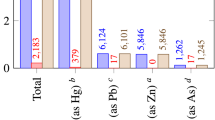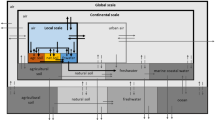Abstract
Purpose
The classification step is systematically neglected in the calculation of life cycle impact assessment indicators: for several direct contribution of one pollutant to several impact categories, the distribution between these impact categories is not accounted. The proposed approaches of non-redundant classification are based on the probability that an emitted substance and its chemically degraded forms are involved into several environmental impacts.
Methods
Two types of repartitions are examined in this paper: (1) one called equiprobable classification, based on identical probability of contributions to several impact categories, and (2) and one called zone classification based. Both methods are based on a classification coefficient alpha and require categorization of chemical pathways (reactive, suspensive, direct, indirect). The first method, the equiprobable classification, is a quick method that allows avoiding multiple counting of pollutants. The second method, the zone classification method, is based on two steps: (1) the first step requires defining an impacted zone around the source, inside which the emitted chemicals are expected to majorly diffuse or spread, and (2) in the second step, the score of the chemical is set according to the occurrence of the chemical target inside the impacted zone.
Results
Both methods are applied on a case study of NOx emissions in Paris. Results highlight big differences (33% to 47%) when using or not the classification coefficient. Coefficients calculated using equiprobable or zone classifications are of the same order of magnitude except for indirect contributions.
Discussion
The zone classification method is compared to other site-specific life cycle assessment methods. The choices of impacted zone and of chemical targets are discussed with the aim to meeting paradoxical constraints: local parameters must be sufficiently detailed in the majority of cases, but generic enough to avoid time consuming researches. The availability of data is also discussed as well as the possibility to include indirect impacts into the environmental system.
Conclusions
The conceptual frame suggested for classification of pollutants into emission-based impact categories is a first approach for a scientific question that was raised in the 90s. Equiprobable classification is easy to apply but not entirely satisfying from a physical and chemical background. Zone classification relies upon the specificity of emission compartments and occurrence of chemical targets in the impacted zone. It still needs improvements. It has important consequences in terms of data collection, system boundaries, and only practice will show its actual feasibility.




Similar content being viewed by others
References
ASHRAE (2007) Building air intake and exhaust design. Chapter 44, ASHRAE applications handbook. American Society of Heating, Refrigeration and Air-Conditioning Engineers, Inc, Atlanta
Bare JC, Gloria TP (2008) Environmental impact assessment taxonomy providing comprehensive coverage of midpoints, endpoints, damages, and areas of protection. J Cleaner Prod 16:1021–1035
Bennett DH, Scheringer M, McKone TE, Hungerbühler K (2001) Predicting long-range transport: a systematic evaluation of two multimedia transport models. Environ Sci Technol 35(6):1181–1189
Brent A (2004) A life cycle impact assessment procedure with resource groups as areas of protection. Int J LCA 9(3):172–179
Consoli F, Allen D, Boustead I, Fava J, Franklin W, Jensen AA, de Oude N, Parrish R, Postlethwaite D, Quay B, Siéguin J, Vigon B (eds) (1993) Guidelines for life cycle assessment. A code of practice. Society of Environmental Toxicology and Chemistry–Europe and North America, Brussels
EPLCA (2008) European Platform on LCA, International Reference Life Cycle Data System (ILCD) Handbook, ILCD reference elementary flows table. http://lct.jrc.ec.europa.eu/pdf-directory/ILCD-Handbook-General-guide-for-LCA-DETAIL-online-12March2010.pdf. Accessed November 2010
FAO (2008) Global Forest Resources Assessment, Food and Agriculture Organization of the United Nations. http://www.fao.org/forestry/41256/fr/. Accessed November 2010
Fenimore CP (1971) Formation of nitric oxide in premixed hydrocarbon flames. In: 13th International Symposium on Combustion, Combustion Institute, Pittsburgh, PA, 1971, pp 373–380
Huijbregts MAJ, Thissen U, Guinée JB, Jager T, Kalf D, van de Meent D, Ragas AMJ, Wegener SA, Reijnders L (2001) Priority assessment of toxic substances in life cycle assessment. Part I. Calculation of toxicity potentials for 181 substances with the nested multi-media fate, exposure and effects model USES-LCA. Chemosphere 41:541–573
Huijbregts MAJ, Lundi S, McKone TE, van de Meent D (2003) Geographical scenario uncertainty in generic fate and exposure factors of toxic pollutants for life-cycle impact assessment. Chemosphere 51:501–508
Huijbregts MAJ, Struijs J, Goedkoop M, Heijungs R, Hendriks AJ, van de Meent D (2005) Human population intake fractions and environmental fate factors of toxic pollutants in life cycle impact assessment. Chemosphere 61(10):1495–1504
Jolliet OJ, Wannaz C, Fantke P (2010) Multiscale, multimedia modelling to compare local and global life cycle impacts on human health. In: 20th SETAC Europe annual meeting, Seville (Spain), 23–27 May 2010, Abstract LC04C-3
JORF (2008) Arrêté du 2 décembre 2008 modifiant l’arrêté du 25 juillet 1997 relatif aux prescriptions générales applicables aux installations classées pour la protection de l’environnement soumises à déclaration sous la rubrique n° 2910 (Combustion). Journal Officiel de la République Française n°291 du 14 Décembre 2008
Mackay D, Reid L (2008) Local and distant residence times of contaminants in multi-compartment models. Part I. A review of the theoretical basis. Environ Pollut 156:1196–1203
McKone TE, Bennett DH (2003) Chemical-specific representation of air–soil exchange and soil penetration in regional multimedia models. Environ Sci Technol 37(14):3123–3132
MeteoFrance (2009). Meteo France. http://france.meteofrance.com. Accessed November 2010
Miller JD, Bowman CT (1989) Mechanism and modelling of nitrogen chemistry in combustion. Prog Energy Combust Sci 15:287–338
OSE (2008) Ressources en eaux—eaux de surface. Observatoire et Statistiques de l’Environnement du Ministère de l’Ecologie, de l’Energie, du Développement Durable et de la Mer. http://www.ifen.fr/acces-thematique/eau/ressources-en-eau/les-eaux-de-surface.html. last update June 2010, accessed November 2010
OSE (2009) Observatoire national des zones humides—les zones humides en France. Observatoire et Statistiques de l’Environnement du Ministère de l’Ecologie, de l’Energie, du Développement Durable et de la Mer. http://www.ifen.fr/acces-thematique/territoire/zones-humides/onzh/les-zones-humides-en-france.html. last update March 2010, accessed November 2010
Potting J (1994) Spatial differentiation in life cycle impact assessment. PhD Utrecht University, 177 pp, NWS-E-2000-02
Potting J, Hauschild M (2005) Background for spatial differentiation in LCA impact assessment—the EDIP2003 methodology. Environmental Project No. 996 2005, Danish Ministry of the Environment. http://www2.mst.dk/Udgiv/publications/2005/87-7614-581-6/pdf/87-7614-582-4.pdf. Accessed November 2010
Raugei M, Ulgiati S (2009) A novel approach to the problem of geographic allocation of environmental impact in life cycle assessment and material flow analysis. Ecol Ind 9:1257–1264
Reap J, Roman F, Duncan S, Bras B (2008) A survey of unresolved problems in life cycle assessment. Part II. Impact assessment and interpretation. Int J LCA 13:374–388
Reid L, Mackay D (2008) Local and distant residence times of contaminants in multi-compartment models. Part II. Application to assessing environmental mobility and long-time range atmospheric transport. Environ Pollut 156:1182–1189
Rosenbaum RK, Bachmann TM, Gold LS, Huijbregts MAJ, Jolliet O, Juraske R, Koehler A, Larsen HF, MacLeod M, Margni M, McKone T, Payet J, Schuhmacher M, van de Meent D, Hauschild M (2008) USEtox—the UNEP/SETAC toxicity model: recommended characterisation factors for human toxicity and freshwater ecotoxicity in life cycle impact assessment. Int J LCA 13:532–546
Sayagh S, Ventura A, Hoang T, François D, Jullien A (2009) Sensitivity of the LCA allocation procedure for BFS recycled into pavement structures. Resour Conserv Recycl 54:348–358
Singhofen A, Hemming C, Weidema B, Grisel L, Bretz R, de Smet B, Russell D (1996) Life cycle inventory data: development of a common format. Int J LCA 1(3):171–178
Tomita A (2001) Suppression of nitrogen oxides emission by carbonaceous reductants. Fuel Process Technol 71:53–70
Udo de Haes HA (1996) Part I. Discussion of general principles and guidelines for practical use. In: Udo de Haes HA (ed) Towards a methodology for life cycle impact assessment. SETAC Europe, Brussels
US-EPA (2010) Technology transfer network clearinghouse for inventories & emissions factors, emissions factors & AP 42, Compilation of Air Pollutant Emission Factors. http://www.epa.gov/ttnchie1/ap42/. Accessed November 2010
Ventura A, Monéron P, Jullien A (2008) Environmental impact of a binding course pavement section, with asphalt recycled at varying rates—use of life cycle methodology. J Road Mater Pavement Des 9:319–338, Special Issue EATA 2008
Webster E, Mackay D, Di Guardo A, Kane D, Woodfine D (2004) Regional differences in chemical fate model outcome. Chemosphere 55:1361–1376
Wikipedia (2009) Liste des plus grands lacs et étangs de France. http://fr.wikipedia.org/wiki/Liste_des_plus_grands_lacs_et_étangs_de_France. Accessed November 2010
Author information
Authors and Affiliations
Corresponding author
Rights and permissions
About this article
Cite this article
Ventura, A. Classification of chemicals into emission-based impact categories: a first approach for equiprobable and site-specific conceptual frames. Int J Life Cycle Assess 16, 148–158 (2011). https://doi.org/10.1007/s11367-010-0242-x
Received:
Accepted:
Published:
Issue Date:
DOI: https://doi.org/10.1007/s11367-010-0242-x




